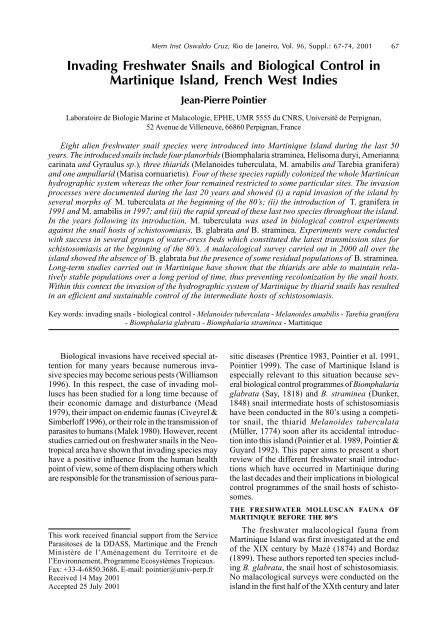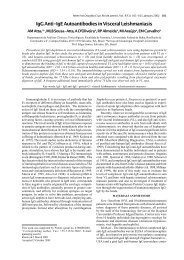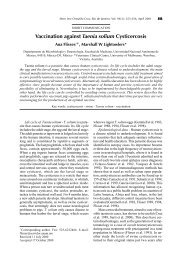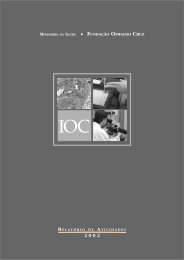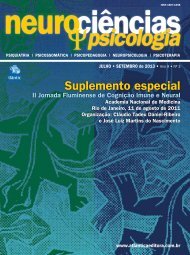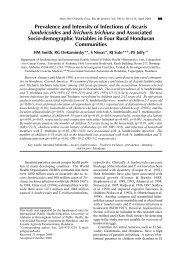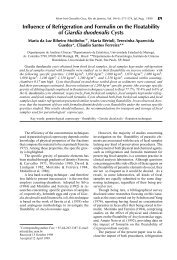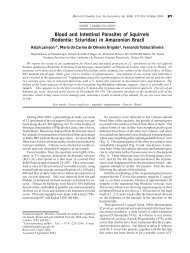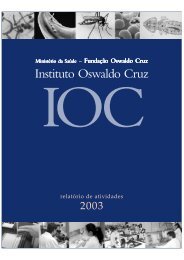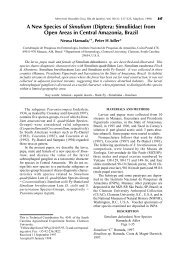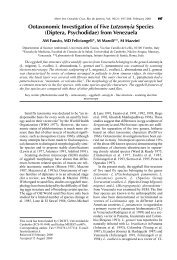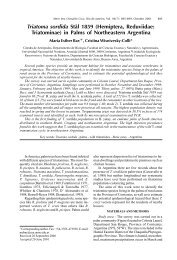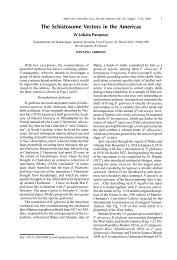Invading Freshwater Snails and Biological Control in ... - SciELO
Invading Freshwater Snails and Biological Control in ... - SciELO
Invading Freshwater Snails and Biological Control in ... - SciELO
You also want an ePaper? Increase the reach of your titles
YUMPU automatically turns print PDFs into web optimized ePapers that Google loves.
Mem Inst Oswaldo Cruz, Rio de Janeiro, Vol. 96, Suppl.: 67-74, 200167<strong>Invad<strong>in</strong>g</strong> <strong>Freshwater</strong> <strong>Snails</strong> <strong>and</strong> <strong>Biological</strong> <strong>Control</strong> <strong>in</strong>Mart<strong>in</strong>ique Isl<strong>and</strong>, French West IndiesJean-Pierre Po<strong>in</strong>tierLaboratoire de Biologie Mar<strong>in</strong>e et Malacologie, EPHE, UMR 5555 du CNRS, Université de Perpignan,52 Avenue de Villeneuve, 66860 Perpignan, FranceEight alien freshwater snail species were <strong>in</strong>troduced <strong>in</strong>to Mart<strong>in</strong>ique Isl<strong>and</strong> dur<strong>in</strong>g the last 50years. The <strong>in</strong>troduced snails <strong>in</strong>clude four planorbids (Biomphalaria stram<strong>in</strong>ea, Helisoma duryi, Ameriannacar<strong>in</strong>ata <strong>and</strong> Gyraulus sp.), three thiarids (Melanoides tuberculata, M. amabilis <strong>and</strong> Tarebia granifera)<strong>and</strong> one ampullarid (Marisa cornuarietis). Four of these species rapidly colonized the whole Mart<strong>in</strong>icanhydrographic system whereas the other four rema<strong>in</strong>ed restricted to some particular sites. The <strong>in</strong>vasionprocesses were documented dur<strong>in</strong>g the last 20 years <strong>and</strong> showed (i) a rapid <strong>in</strong>vasion of the isl<strong>and</strong> byseveral morphs of M. tuberculata at the beg<strong>in</strong>n<strong>in</strong>g of the 80’s; (ii) the <strong>in</strong>troduction of T. granifera <strong>in</strong>1991 <strong>and</strong> M. amabilis <strong>in</strong> 1997; <strong>and</strong> (iii) the rapid spread of these last two species throughout the isl<strong>and</strong>.In the years follow<strong>in</strong>g its <strong>in</strong>troduction, M. tuberculata was used <strong>in</strong> biological control experimentsaga<strong>in</strong>st the snail hosts of schistosomiasis, B. glabrata <strong>and</strong> B. stram<strong>in</strong>ea. Experiments were conductedwith success <strong>in</strong> several groups of water-cress beds which constituted the latest transmission sites forschistosomiasis at the beg<strong>in</strong>n<strong>in</strong>g of the 80’s. A malacological survey carried out <strong>in</strong> 2000 all over theisl<strong>and</strong> showed the absence of B. glabrata but the presence of some residual populations of B. stram<strong>in</strong>ea.Long-term studies carried out <strong>in</strong> Mart<strong>in</strong>ique have shown that the thiarids are able to ma<strong>in</strong>ta<strong>in</strong> relativelystable populations over a long period of time, thus prevent<strong>in</strong>g recolonization by the snail hosts.With<strong>in</strong> this context the <strong>in</strong>vasion of the hydrographic system of Mart<strong>in</strong>ique by thiarid snails has resulted<strong>in</strong> an efficient <strong>and</strong> susta<strong>in</strong>able control of the <strong>in</strong>termediate hosts of schistosomiasis.Key words: <strong>in</strong>vad<strong>in</strong>g snails - biological control - Melanoides tuberculata - Melanoides amabilis - Tarebia granifera- Biomphalaria glabrata - Biomphalaria stram<strong>in</strong>ea - Mart<strong>in</strong>ique<strong>Biological</strong> <strong>in</strong>vasions have received special attentionfor many years because numerous <strong>in</strong>vasivespecies may become serious pests (Williamson1996). In this respect, the case of <strong>in</strong>vad<strong>in</strong>g molluscshas been studied for a long time because oftheir economic damage <strong>and</strong> disturbance (Mead1979), their impact on endemic faunas (Civeyrel &Simberloff 1996), or their role <strong>in</strong> the transmission ofparasites to humans (Malek 1980). However, recentstudies carried out on freshwater snails <strong>in</strong> the Neotropicalarea have shown that <strong>in</strong>vad<strong>in</strong>g species mayhave a positive <strong>in</strong>fluence from the human healthpo<strong>in</strong>t of view, some of them displac<strong>in</strong>g others whichare responsible for the transmission of serious para-This work received f<strong>in</strong>ancial support from the ServiceParasitoses de la DDASS, Mart<strong>in</strong>ique <strong>and</strong> the FrenchM<strong>in</strong>istère de l’Aménagement du Territoire et del’Environnement, Programme Ecosystèmes Tropicaux.Fax: +33-4-6850.3686. E-mail: po<strong>in</strong>tier@univ-perp.frReceived 14 May 2001Accepted 25 July 2001sitic diseases (Prentice 1983, Po<strong>in</strong>tier et al. 1991,Po<strong>in</strong>tier 1999). The case of Mart<strong>in</strong>ique Isl<strong>and</strong> isespecially relevant to this situation because severalbiological control programmes of Biomphalariaglabrata (Say, 1818) <strong>and</strong> B. stram<strong>in</strong>ea (Dunker,1848) snail <strong>in</strong>termediate hosts of schistosomiasishave been conducted <strong>in</strong> the 80’s us<strong>in</strong>g a competitorsnail, the thiarid Melanoides tuberculata(Müller, 1774) soon after its accidental <strong>in</strong>troduction<strong>in</strong>to this isl<strong>and</strong> (Po<strong>in</strong>tier et al. 1989, Po<strong>in</strong>tier &Guyard 1992). This paper aims to present a shortreview of the different freshwater snail <strong>in</strong>troductionswhich have occurred <strong>in</strong> Mart<strong>in</strong>ique dur<strong>in</strong>gthe last decades <strong>and</strong> their implications <strong>in</strong> biologicalcontrol programmes of the snail hosts of schistosomes.THE FRESHWATER MOLLUSCAN FAUNA OFMARTINIQUE BEFORE THE 80’SThe freshwater malacological fauna fromMart<strong>in</strong>ique Isl<strong>and</strong> was first <strong>in</strong>vestigated at the endof the XIX century by Mazé (1874) <strong>and</strong> Bordaz(1899). These authors reported ten species <strong>in</strong>clud<strong>in</strong>gB. glabrata, the snail host of schistosomiasis.No malacological surveys were conducted on theisl<strong>and</strong> <strong>in</strong> the first half of the XXth century <strong>and</strong> later
68 <strong>Invad<strong>in</strong>g</strong> <strong>Snails</strong> <strong>and</strong> <strong>Biological</strong> <strong>Control</strong> <strong>in</strong> Mart<strong>in</strong>ique • J-P Po<strong>in</strong>tiera first <strong>in</strong>ventory was carried out by Dreyfuss (1953)who confirmed the presence of four planorbid species.At that time, B. glabrata was apparently acommonly distributed species throughout the isl<strong>and</strong>.In 1967, Grétillat reported six species alreadycited <strong>in</strong> the previous surveys <strong>and</strong> a new record forthe isl<strong>and</strong>, B. stram<strong>in</strong>ea. The same year, the occurrenceof this latter species was confirmed byParaense (pers. commun.) <strong>and</strong> a malacological surveycarried out between 1972 <strong>and</strong> 1978 by Guyard<strong>and</strong> Po<strong>in</strong>tier (1979). In addition these authors reportedfor the first time the presence of anotherplanorbid snail, Helisoma duryi (Wetherby, 1879).A total of 17 freshwater molluscs (Figs 1-2) werelisted <strong>in</strong> this <strong>in</strong>ventory <strong>in</strong>clud<strong>in</strong>g six planorbids [B.glabrata, B. stram<strong>in</strong>ea, B. schrammi (Crosse, 1864),Drepanotrema lucidum (Pfeiffer, 1839), D. cimex(Moric<strong>and</strong>, 1837), H. duryi], two physids [Physacubensis Pfeiffer, 1839, P. marmorata (Guild<strong>in</strong>g,1828)], one lymnaeid (Lymnaea cubensis Pfeiffer,1839), one ancylid [Gundlachia radiata (Guild<strong>in</strong>g,1828)], one hydrobid [Pyrgophorus coronatus(Pfeiffer, 1840)], three neritids [Nerit<strong>in</strong>a punctulataLamarck, 1816, N. virg<strong>in</strong>ea (L<strong>in</strong>naeus, 1758),Neritillia succ<strong>in</strong>ea (Recluz, 1841)], one ampullarid[Pomacea glauca (L<strong>in</strong>naeus, 1758)] <strong>and</strong> twobivalves [Eupera viridans (Prime 1865), Pisidiumpunctiferum (Guppy, 1869)]. Moreover, the authorsreported dense populations <strong>and</strong> a very wide distributionof B. stram<strong>in</strong>ea <strong>in</strong> the whole hydrographicsystem of Mart<strong>in</strong>ique, confirm<strong>in</strong>g that a successful<strong>in</strong>vasion occurred several years ago. Two otherspecies cited <strong>in</strong> the literature, Drepanotremadepressissimum (Moric<strong>and</strong>, 1839) <strong>and</strong> D.aerug<strong>in</strong>osum (Morelet, 1851) could not be collecteddur<strong>in</strong>g this survey (see <strong>in</strong> Mazé 1874, Harry& Hubendick 1964). Thus, <strong>in</strong> 1978, two molluscsout of 17 were considered as <strong>in</strong>troduced species,B. stram<strong>in</strong>ea <strong>and</strong> H. duryi (Fig. 2J, K).The case of two other common species, B.glabrata <strong>and</strong> Physa cubensis, must also be emphasized.As already po<strong>in</strong>ted out, B. glabrata occurred<strong>in</strong> Mart<strong>in</strong>ique <strong>in</strong> the XIX century <strong>and</strong> wasrecorded as a native species. However, this snailhas a very wide distribution area extend<strong>in</strong>g fromthe Greater Antilles to south of Brazil <strong>and</strong> recentlydemonstrated its <strong>in</strong>vasive capabilities <strong>in</strong> Egyptwhere it is presently coloniz<strong>in</strong>g the Nile delta area(Kristensen et al. 1999). Moreover, recent geneticstudies revealed strong African aff<strong>in</strong>ities of thisspecies suggest<strong>in</strong>g a non-American orig<strong>in</strong>(B<strong>and</strong>oni et al. 1995, Woodruff & Mulvey 1997). Itsstatus as a native species <strong>in</strong> Mart<strong>in</strong>ique is thusquestionable. Similarly, the orig<strong>in</strong> of P. cubensis isalso questionable. Physid snails are considered asvery good travellers as a consequence of the great<strong>in</strong>crease of the aquarium <strong>in</strong>dustry <strong>and</strong> aquatic planttrade dur<strong>in</strong>g the last decades <strong>and</strong> these snails maycolonize a great variety of anthropized habitats(Madsen & Fr<strong>and</strong>sen 1989). Moreover, their identificationus<strong>in</strong>g morphological characters is difficultbecause of their shell variability <strong>and</strong> the lack ofreliable anatomical studies. Consequently their taxonomicstatus still rema<strong>in</strong>s quite confus<strong>in</strong>g (Brown1994).THE INCREASE OF ALIEN SNAIL INTRODUCTIONSIN THE 80’S AND 90’S AND BIOLOGICALCONTROL PROGRAMMES IN MARTINIQUEA strong <strong>in</strong>crease of snail <strong>in</strong>troductions wasobserved <strong>in</strong> Mart<strong>in</strong>ique dur<strong>in</strong>g the last two decades.In 1979, the thiarid snail M. tuberculata wasdiscovered for the first time <strong>in</strong> Madame River, Fortde-France,<strong>and</strong> <strong>in</strong> two other waterbodies <strong>in</strong> thenorthern part of the isl<strong>and</strong> (Po<strong>in</strong>tier & McCullough1989). Conchological studies showed the presenceof two dist<strong>in</strong>ct morphs differ<strong>in</strong>g <strong>in</strong> their color <strong>and</strong>sculpture patterns (Po<strong>in</strong>tier 1989). The first morphnamed MAD (from Madame River) has a pale todark brown shell with numerous reddish brownflames. Body whorls are slightly rounded with spiralgrooves <strong>and</strong> axial undulat<strong>in</strong>g ribs flatten<strong>in</strong>g onthe latter whorls (Fig. 2A). The second morph namedFAL (from Falaise River) has a white shell with numerousreddish brown flames <strong>and</strong> spots. Bodywhorls are well rounded with spiral grooves <strong>and</strong>axial <strong>and</strong> spiral rows of tubercles (Fig. 2D).At the beg<strong>in</strong>n<strong>in</strong>g of 1983, a biological controlexperiment us<strong>in</strong>g M. tuberculata as a competitorof B. glabrata <strong>and</strong> B. stram<strong>in</strong>ea was <strong>in</strong>itiated <strong>in</strong>two groups of water-cress beds which were activetransmission sites for schistosomiasis <strong>in</strong> 1981 <strong>and</strong>1982 (Po<strong>in</strong>tier et al. 1984). In January 1983, 700 M.tuberculata were <strong>in</strong>troduced <strong>in</strong>to the first group ofwater-cress beds (represent<strong>in</strong>g a density of 1.3 <strong>in</strong>dividuals/m2 ) <strong>and</strong> 700 <strong>in</strong> the second group (represent<strong>in</strong>ga density of 1.6 <strong>in</strong>dividuals/m 2 ). From November1981 to January 1983, the period prior tothe <strong>in</strong>troduction of M. tuberculata, the water-cressbeds harboured a population of B. glabrata vary<strong>in</strong>gfrom 45 to 256 <strong>in</strong>dividuals/m 2 as well as a populationof B. stram<strong>in</strong>ea vary<strong>in</strong>g from 2 to 30 <strong>in</strong>dividuals/m2 (Po<strong>in</strong>tier et al. 1984). The resultsshowed a very rapid colonization by the competitorsnail, with densities reach<strong>in</strong>g a maximum of 9,941<strong>and</strong> 13,388 <strong>in</strong>dividuals/m 2 at 10 <strong>and</strong> 20 months respectivelyafter its <strong>in</strong>troduction <strong>in</strong>to the two groupsof water-cress beds. Dur<strong>in</strong>g that time, the B.glabrata <strong>and</strong> B. stram<strong>in</strong>ea populations decl<strong>in</strong>ed<strong>and</strong> disappeared completely from sampl<strong>in</strong>gs <strong>in</strong> 1985(Po<strong>in</strong>tier et al. 1989). Follow<strong>in</strong>g this first success,M. tuberculata was <strong>in</strong>troduced <strong>in</strong>to the other groupsof beds which were <strong>in</strong>ventoried all over the isl<strong>and</strong>.The results confirmed those achieved dur<strong>in</strong>g the
Mem Inst Oswaldo Cruz, Rio de Janeiro, Vol. 96, Suppl., 200169Fig. 1: freshwater malacological fauna of Mart<strong>in</strong>ique. Native species. A: Nerit<strong>in</strong>a virg<strong>in</strong>ea, Rivière Pilote (21.9 <strong>and</strong> 21.2mm); B: N. punctulata, Lorra<strong>in</strong> River (29.0 <strong>and</strong> 29.3 mm); C: Neritillia succ<strong>in</strong>ea, Fond Bourlet River (5.4 <strong>and</strong> 5.2 mm);D: Pomacea glauca, Sa<strong>in</strong>t-Pierre River (53.2 <strong>and</strong> 50.2 mm); E: Pyrgophorus coronatus, Madame River (5.7 <strong>and</strong> 5.1mm); F: Physa cubensis, Falaise spr<strong>in</strong>g (8.8 <strong>and</strong> 8.7 mm); G: P. marmorata, Sa<strong>in</strong>te Marie canal (12.0 <strong>and</strong> 11.1 mm); H:Lymnaea cubensis, Anse Rivière marsh (9.2 mm); I: Drepanotrema cimex, Boisneuf marsh (6.4, 6.0 <strong>and</strong> 6.3 mm); J: D.lucidum, Boisneuf marsh (6.0, 6.4 <strong>and</strong> 6.6 mm); K: Biomphalaria glabrata, Boisneuf marsh (21.2, 22.1 <strong>and</strong> 22.6 mm);L: Eupera viridans, Sa<strong>in</strong>te Luce pond (5.5 mm); M: Pisidium punctiferum, Pelletier rav<strong>in</strong>e (2.2 mm)
70 <strong>Invad<strong>in</strong>g</strong> <strong>Snails</strong> <strong>and</strong> <strong>Biological</strong> <strong>Control</strong> <strong>in</strong> Mart<strong>in</strong>ique • J-P Po<strong>in</strong>tierfirst experiment <strong>and</strong> <strong>in</strong> 1990 B. glabrata <strong>and</strong> B.stram<strong>in</strong>ea were absent or very rare <strong>in</strong> this type ofhabitat (Po<strong>in</strong>tier & Guyard 1992).Concomitantly, several malacological surveysconducted <strong>in</strong> the 1980s revealed a rapid spread ofM. tuberculata all over the isl<strong>and</strong>. A third morphpreviously discovered <strong>in</strong> Guadeloupe was found<strong>in</strong> several sites <strong>in</strong> 1986. This morph named PAP(from Po<strong>in</strong>te-à-Pitre) has a pale to dark brown shellwith numerous reddish brown flames. Body whorlsare slightly rounded with spiral grooves. Axial ribsare present on the first whorls but disappear <strong>in</strong> thesix to seven last whorls (Fig. 2B). From 1986 to 1990,a strong decl<strong>in</strong>e of one morph (FAL) was observedfollow<strong>in</strong>g the spread of the two others (MAD, PAP)suggest<strong>in</strong>g a competitive displacement betweenmorphs (Po<strong>in</strong>tier et al. 1993).Two pulmonate species, Gyraulus sp. <strong>and</strong>Amerianna car<strong>in</strong>ata (H. Adams, 1861) as well asthe ampullarid Marisa cornuarietis (L<strong>in</strong>naeus,1758) were also <strong>in</strong>troduced <strong>in</strong> the 80’s. Gyraulussp. (Fig. 2L) was discovered <strong>in</strong> 1982 <strong>in</strong> a watercressbed near the Falaise River (unpublished data).This snail is also considered as a good traveller<strong>and</strong> is often <strong>in</strong>troduced with aquatic plants usedby aquarists (Madsen & Fr<strong>and</strong>sen 1989). InMart<strong>in</strong>ique, it rema<strong>in</strong>ed at the same site dur<strong>in</strong>g severalyears but disappeared at the end of the 80’sfollow<strong>in</strong>g the destruction of the water-cress beds.The ampullarid M. cornuarietis (Fig. 2I) was discovered<strong>in</strong> two marshy areas located beh<strong>in</strong>d a mangroveforest <strong>in</strong> 1987 (Anse Rivière <strong>and</strong> QuartierBoisneuf, unpublished data). Apparently it rema<strong>in</strong>edrestricted to these two sites <strong>in</strong> the follow<strong>in</strong>gyears. The Australian planorbid snail A.car<strong>in</strong>ata (Fig. 2M) was discovered <strong>in</strong> 1987 <strong>in</strong> somesmall refuges along the banks of the Galion River(Po<strong>in</strong>tier 1996). It colonized rapidly the whole isl<strong>and</strong>but rema<strong>in</strong>ed restricted to particular micro-habitatssheltered from seasonal flood<strong>in</strong>gs along theriver banks.In the 90’s, other alien snail <strong>in</strong>troductions followed<strong>in</strong> Mart<strong>in</strong>ique. Another morph of M.tuberculata was discovered <strong>in</strong> Madame River, Fortde-France<strong>in</strong> 1990 <strong>and</strong> named PDC (from Pont-de-Chaînes). The shell is greenish to pale brown withnumerous reddish brown spots <strong>and</strong> flames. Flamesare well marked below sutures. Body whorls areslightly rounded with spiral grooves (Fig. 2C). Thismorph colonized several rivers <strong>and</strong> streams <strong>in</strong> thefollow<strong>in</strong>g years. In 1991 another thiarid species,Tarebia granifera (Fig. 2H) was discovered <strong>in</strong> theCharpentier River. It rapidly spread from its <strong>in</strong>troductionsite <strong>and</strong> by 1997 thirteen river systems werecolonized. T. granifera quickly outnumbered M.tuberculata <strong>in</strong> rivers already colonized by this speciesbut it never wiped it out (Po<strong>in</strong>tier et al. 1998).In 1993, a fifth morph of M. tuberculata wasdiscovered <strong>in</strong> the Coulisses River at Petit Fond <strong>and</strong>named CPF (Fig. 2F). The shell is whitish with numerousreddish to brown spots <strong>and</strong> flames. Bodywhorls are slightly rounded with spiral grooves <strong>and</strong>axial undulat<strong>in</strong>g ribs flatten<strong>in</strong>g on the latter whorls.This morph displays some common conchologicalcharacters with FAL <strong>and</strong> PAP, both morphs whichalready occurred together <strong>in</strong> this river. A geneticanalysis us<strong>in</strong>g DNA microsatellites as markersshowed that this new morph can be <strong>in</strong>terpreted asa hybrid between FAL <strong>and</strong> PAP morphs (Samadi etal. 1999). The follow<strong>in</strong>g year, <strong>in</strong> 1994, another hybridmorph was found <strong>in</strong> the Madame River, Fortde-France<strong>and</strong> named FDF (Fig. 2E). This morphhas been <strong>in</strong>terpreted as a hybrid between FAL <strong>and</strong>PDC morphs (Samadi et al. 1999). Its shell is whitishto pale brown with reddish brown spots <strong>and</strong> flames.Flames <strong>and</strong> spots are well marked below sutures as<strong>in</strong> PDC shells. Body whorls are slightly roundedwith spiral grooves <strong>and</strong> axial undulat<strong>in</strong>g ribs flatten<strong>in</strong>gon the latter whorls. The first hybrid morph(CPF) is now present <strong>in</strong> three river systems whereasthe second (FDF) rema<strong>in</strong>s restricted to the MadameRiver.F<strong>in</strong>ally, <strong>in</strong> 1997 another thiarid snail identifiedas M. amabilis (Reeve, 1860) was discovered <strong>in</strong> theGondeau River. This thiarid resembles M.tuberculata (Fig. 2G) but its shell is whitish to darkbrown with a s<strong>in</strong>gle row of reddish brown spotsbelow sutures more or less marked. Body whorlsare flat with no spiral grooves. The first whorlshave axial <strong>and</strong> spiral rows of m<strong>in</strong>ute tubercles disappear<strong>in</strong>grapidly on the five or six last whorls. M.amabilis is presently the dom<strong>in</strong>ant thiarid <strong>in</strong> theGondeau River <strong>and</strong> has recently been found <strong>in</strong> threeother Mart<strong>in</strong>ican rivers.CONSEQUENCES OF THE INVASION OF THIARIDSON THE SNAIL HOSTS OF SCHISTOSOMESAs already po<strong>in</strong>ted out, the biological controlprogramme undertaken <strong>in</strong> water-cress beds ofMart<strong>in</strong>ique can be considered to be successfulbecause it resulted <strong>in</strong> the elim<strong>in</strong>ation of the snailhosts from almost half of the habitats; <strong>in</strong> the rema<strong>in</strong><strong>in</strong>gsites, B. glabrata <strong>and</strong> B. stram<strong>in</strong>ea wereat very low densities, probably without epidemiologicalsignificance for the transmission of schistosomes(Po<strong>in</strong>tier & Guyard 1992). In 1996, anothermalacological survey was carried out <strong>in</strong> all groupsof water-cress beds <strong>and</strong> confirmed the control successof both snail hosts (Table). B. stram<strong>in</strong>ea wasstill present <strong>in</strong> half of the water-cress beds but onlya few <strong>in</strong>dividuals could be collected <strong>in</strong> these sitescolonized by M. tuberculata. The most strik<strong>in</strong>g resultwas the absence of B. glabrata from all watercressbeds. When snail densities are very low, it is
Mem Inst Oswaldo Cruz, Rio de Janeiro, Vol. 96, Suppl., 200171Fig. 2: freshwater malacological fauna of Mart<strong>in</strong>ique. Introduced species. A: Melanoides tuberculata, MAD morph,Madame River (24.5 <strong>and</strong> 24.7 mm); B: M. tuberculata, PAP morph, Coulisses River (25.5 <strong>and</strong> 25.2 mm); C: M.tuberculata, PDC morph, Coulisses River (24.2 <strong>and</strong> 25.2 mm); D: M. tuberculata, FAL morph, Ep<strong>in</strong>ette River (26.4 <strong>and</strong>26.8 mm); E: M. tuberculata, FDF morph = FAL x PDC hybrid (25.2 <strong>and</strong> 24.5 mm); F: M. tuberculata, CPF morph = FALx PAP hybrid (25.3 <strong>and</strong> 26.3 mm); G: M. amabilis, Gondeau River (24.0 <strong>and</strong> 22.9 mm); H: Tarebia granifera, CharpentierRiver (23.7 <strong>and</strong> 23.8 mm); I: Marisa cornuarietis, Anse Rivière marsh (53.2 mm); J: Biomphalaria stram<strong>in</strong>ea, Sa<strong>in</strong>teMarie canal (9.0, 9.2 <strong>and</strong> 9.4 mm); K: Helisoma duryi, Leyritz tank (15.5, 15.0 <strong>and</strong> 15.5 mm); Gyraulus sp. Falaise watercress(3.8, 3.5 <strong>and</strong> 3.7 mm); M: Amerianna car<strong>in</strong>ata, Galion River (8.6 <strong>and</strong> 9.2 mm)
TABLEMa<strong>in</strong> characteristics of the water-cress beds of Mart<strong>in</strong>ique where a biological control programme was carried out us<strong>in</strong>g the competitor snail Melanoides tuberculata aga<strong>in</strong>stBiomphalaria glabrata (Bg) <strong>and</strong> B. stram<strong>in</strong>ea (Bs), snail <strong>in</strong>termediate hosts of schistosomiasis <strong>in</strong> the 80’sSnail Competitor Mean density of the State of control State of controlWater-cress bed Surface m 2 Type of soil hosts <strong>in</strong>troduction competitor (<strong>in</strong>d.m 2 ±SD) <strong>in</strong> 1990 <strong>in</strong> 19963 years after its <strong>in</strong>troductionRoxelane 1 530 Mud Bg + Bs Jan. 1983 5,900 ± 1,050 Snail disappearance Snail disappearanceRoxelane 2 450 Mud Bg + Bs Jan. 1983 7,260 ± 2,690 Snail disappearance Some BsRoxelane 3 217 Mud + gravel Bs Jan. 1984 2,685 ± 770 Snail disappearance Some BsRoxelane 4 138 Mud Bs Jan. 1984 15,780 ± 7,150 Some Bs Some BsPo<strong>in</strong>te la Mare 1 360 Mud Bg + Bs Nov. 1983 12,210 ± 2,760 Some Bg + Bs Some BsPo<strong>in</strong>te la Mare 2 165 Mud Bg + Bs Nov. 1983 11,270 ± 1,730 Some Bg + Bs Some BsPo<strong>in</strong>te la Mare 3 150 Mud Bg + Bs Nov. 1983 12,550 ± 2,690 Some Bg + Bs Some BsPo<strong>in</strong>te la Mare 4 315 Mud Bg + Bs Nov. 1983 11,640 ± 1,830 Some Bg + Bs Some BsPo<strong>in</strong>te la Mare 5 120 Mud + gravel Bg + Bs Nov. 1983 7,890 ± 2,030 Some Bs Some BsRoches Carrées 18 Mud Bg + Bs Jul. 1986 7,960 ± 4,770 Some Bg Ab<strong>and</strong>on of culturesHaut Roches Carrées 28 Mud + gravel Bg + Bs Unassisted 5,840 ± 970 Some Bg + Bs Ab<strong>and</strong>on of culturesRivière l’Or 1 48 Gravel Bg Oct. 1984 1,200 ± 450 Snail disappearance Snail disappearanceRivière l’Or 2 144 Gravel Bs Unassisted 1,040 ± 270 Snail disappearance Snail disappearanceHôtel des Plaisirs 33 Mud Bg June 1986 5,560 ± 2,650 Some Bg Snail disappearanceRessource Bassignac 40 Mud Bs Jul. 1986 6,700 ± 3,060 Ab<strong>and</strong>on of cultures Ab<strong>and</strong>on of culturesRivière Falaise 110 Mud + stones Bg + Bs Unassisted 9,930 ± 1,720 Snail disappearance Ab<strong>and</strong>on of culturesHabitation Pécoul 6 Mud Bs Unassisted 8,150 ± 6,230 Ab<strong>and</strong>on of cultures Ab<strong>and</strong>on of culturesRomanet 1 10 Mud Bg + Bs Jul. 1986 8,080 ± 3,330 Some Bs Snail disappearanceRomanet 2 60 Mud Bg Jul. 1986 8,530 ± 2,960 Some Bg Snail disappearanceRomanet 3 12 Mud Bg Jul. 1986 6,300 ± 1,250 Snail disappearance Snail disappearanceRivière des Pères 900 S<strong>and</strong> + gravel Bg + Bs Apr. 1986 2,510 ± 510 Some Bg Some BsBois de l’Union 30 Mud Bs Jul. 1986 5,480 ± 2,310 Snail disappearance Ab<strong>and</strong>on of cultures72 <strong>Invad<strong>in</strong>g</strong> <strong>Snails</strong> <strong>and</strong> <strong>Biological</strong> <strong>Control</strong> <strong>in</strong> Mart<strong>in</strong>ique • J-P Po<strong>in</strong>tier
Mem Inst Oswaldo Cruz, Rio de Janeiro, Vol. 96, Suppl., 200173obviously difficult to achieve irrefutable results <strong>and</strong>it will be necessary to repeat long-term sampl<strong>in</strong>gs<strong>in</strong> these habitats <strong>in</strong> order to have a better assessmentof the malacological situation <strong>and</strong> to be surethat B. glabrata has really been eradicated fromthese habitats.A last survey carried out dur<strong>in</strong>g the dry season2000 <strong>in</strong> the ma<strong>in</strong> streams <strong>and</strong> rivers of Mart<strong>in</strong>iqueconfirmed the <strong>in</strong>vasion of the whole hydrographicsystem by thiarids. Apparently, the ma<strong>in</strong> consequenceof this <strong>in</strong>vasion is the disappearance of B.glabrata <strong>and</strong> the rarefaction of B. stram<strong>in</strong>ea. Theimpact of thiarids upon the other freshwater snailspecies has not been precisely studied. However,it already seems negligible on the five ma<strong>in</strong> prosobranchspecies liv<strong>in</strong>g <strong>in</strong> runn<strong>in</strong>g waters before the<strong>in</strong>troduction of thiarids (P. glauca, N. punctulata,N. virg<strong>in</strong>ea, N. succ<strong>in</strong>ea <strong>and</strong> P. coronatus). Such asituation has already been observed <strong>in</strong> Guadeloupewhere no changes <strong>in</strong> the malacological fauna hasoccurred between 1972 <strong>and</strong> 1996 <strong>in</strong> 134 sites <strong>in</strong> spiteof the <strong>in</strong>vasion by M. tuberculata (Po<strong>in</strong>tier &August<strong>in</strong> 1999). In Mart<strong>in</strong>ique the malacological<strong>in</strong>ventory must be completed <strong>in</strong> other types of habitatssuch as ponds or marshes which are less accessibleto the <strong>in</strong>vasion by thiarids <strong>and</strong> whichharbour several native pulmonate species.In Mart<strong>in</strong>ique the <strong>in</strong>vasion by thiarid snailsappears as an irreversible process. Fortunately, itseems that the benefits of this <strong>in</strong>vasion are moreimportant than the disadvantages because it ma<strong>in</strong>lyresulted <strong>in</strong> an efficient <strong>and</strong> susta<strong>in</strong>able control oftwo snails responsible for the transmission of aserious disease to humans. However, <strong>in</strong> other isl<strong>and</strong>sor countries, this <strong>in</strong>vasion may become a pestbecause of the impact of the <strong>in</strong>vaders on endemicfaunas. This may be the case for some GreaterAntillean isl<strong>and</strong>s such as the Dom<strong>in</strong>ican Republicor Cuba where several endemic thiarids <strong>and</strong>pleurocerids occur.REFERENCESB<strong>and</strong>oni SM, Mulvey M, Loker ES 1995. Phylogeneticanalysis of eleven species of Biomphalaria Preston,1910 (Gastropoda: Planorbidae) based on comparisonsof allozymes. Biol J L<strong>in</strong>n Soc 54: 1-27.Bordaz G 1899. Liste des coquilles recueillies à laMart<strong>in</strong>ique. Bull Soc Hist Nat Autun 12: 5-24.Brown DS 1994. <strong>Freshwater</strong> <strong>Snails</strong> of Africa <strong>and</strong> TheirMedical Importance, Taylor & Francis, London, 609pp.Civeyrel L, Simberloff D 1996. A tale of two snails: isthe cure worse than the disease? Biodiv Conserv 5:1231-1252.Dreyfuss R 1953. Les planorbes de la Mart<strong>in</strong>ique. BulSoc Fr Hist Nat Ant 2: 41-45.Grétillat S 1967. Prospection malacologique aux Antillesfrançaises. Observations sur l’écologie et l’élevageau laboratoire de Lymnaea cubensis. Rev El Méd VétPays Trop 2: 279-289.Guyard A, Po<strong>in</strong>tier JP 1979. Faune malacologiquedulçaquicole et vecteurs de la schistosomose<strong>in</strong>test<strong>in</strong>ale en Mart<strong>in</strong>ique (Antilles françaises). AnnParasitol 54: 193-205.Harry JW, Hubendick B 1964. The freshwater pulmonatemollusca of Puerto Rico. Med Göteborgs MusZool Adv 136: 1-77.Madsen H, Fr<strong>and</strong>sen F 1989. The spread of freshwatersnails <strong>in</strong>clud<strong>in</strong>g those of medical <strong>and</strong> veter<strong>in</strong>ary importance.Acta Trop 46: 139-146.Malek EA 1980. <strong>Snails</strong> Transmitt<strong>in</strong>g Parasitic Diseases,CRC Press, 134 pp.Mazé H 1874. Catalogue des coquilles terrestres etfluviatiles recueillies à la Mart<strong>in</strong>ique en 1873. J Conch22: 158-173.Mead AR 1979. Economic malacology: with particularreference to Achat<strong>in</strong>a fulica. In V Fretter, J Peake(eds), Pulmonates, Academic Press, London, p. 150.Kristensen TK, Yousif F, Raahauge P 1999. Molecularcharacterization of Biomphalaria spp. <strong>in</strong> Egypt. JMoll Stud 65: 133-136.Po<strong>in</strong>tier JP 1989. Comparison between two biologicalcontrol trials of Biomphalaria glabrata <strong>in</strong> a pond <strong>in</strong>Guadeloupe, French West Indies. J Med Appl Mal 1:83-95.Po<strong>in</strong>tier JP 1996. An Australian planorbid freshwatersnail recently <strong>in</strong>troduced to the isl<strong>and</strong> of Mart<strong>in</strong>ique:Amerianna car<strong>in</strong>ata (H. Adams, 1861). Haliotis 25:25-31.Po<strong>in</strong>tier JP 1999. <strong>Invad<strong>in</strong>g</strong> freshwater gastropods: someconflict<strong>in</strong>g aspects for public health. Malacologia41: 403-411.Po<strong>in</strong>tier JP, August<strong>in</strong> D 1999. <strong>Biological</strong> control <strong>and</strong><strong>in</strong>vad<strong>in</strong>g freshwater snails: a case study. CR Acad SciParis 322: 1093-1098.Po<strong>in</strong>tier JP, Guyard A 1992. <strong>Biological</strong> control of thesnail <strong>in</strong>termediate hosts of Schistosoma mansoni <strong>in</strong>Mart<strong>in</strong>ique, French West Indies. Trop Med Parasitol43: 98-101.Po<strong>in</strong>tier JP, McCullough F 1989. <strong>Biological</strong> control ofthe snail hosts of Schistosoma mansoni <strong>in</strong> the Caribbeanarea us<strong>in</strong>g Thiara spp. Acta Trop 46: 147-155.Po<strong>in</strong>tier JP, Guyard A, Mosser A 1989. <strong>Biological</strong> controlof Biomphalaria glabrata <strong>and</strong> B. stram<strong>in</strong>ea bythe competitor snail Thiara tuberculata <strong>in</strong> a transmissionsite of schistosomiasis <strong>in</strong> Mart<strong>in</strong>ique, FrenchWest Indies. Ann Trop Med Parasitol 83: 263-269.Po<strong>in</strong>tier JP, Guyard A, Théron A, Dumoutier A 1984.Le fonctionnement d’un site de transmission à Schistosomamansoni en Mart<strong>in</strong>ique (Antilles françaises).Ann Parasitol 59: 589-595.Po<strong>in</strong>tier JP, Samadi S, Jarne P, Delay B 1998. Introduction<strong>and</strong> spread of Thiara granifera (Lamarck, 1822)<strong>in</strong>to Mart<strong>in</strong>ique isl<strong>and</strong>, French West Indies. BiodivConserv 7: 1277-1290.Po<strong>in</strong>tier JP, Thaler L, Delay B, Pernot F 1993. Invasionof the Mart<strong>in</strong>ique isl<strong>and</strong> by the parthenogenetic snailMelanoides tuberculata <strong>and</strong> succession of morphs.Acta Oecol Int J Ecol 14: 33-42.Po<strong>in</strong>tier JP, Théron A, Imbert-Establet D, Borel G 1991.
74 <strong>Invad<strong>in</strong>g</strong> <strong>Snails</strong> <strong>and</strong> <strong>Biological</strong> <strong>Control</strong> <strong>in</strong> Mart<strong>in</strong>ique • J-P Po<strong>in</strong>tierEradication of a sylvatic focus of Schistosomamansoni us<strong>in</strong>g biological control by competitor snails.Biol Contr 1: 244-247.Prentice MA 1983. Displacement of Biomphalariaglabrata by the snail Thiara granifera <strong>in</strong> field habitats<strong>in</strong> St Lucia, West Indies. Ann Trop Med Parasitol77: 51-59.Samadi S, Mavárez J, Po<strong>in</strong>tier JP, Delay B, Jarne P 1999.Microsatellite <strong>and</strong> morphological analysis of populationstructure <strong>in</strong> the parthenogenetic freshwatersnail Melanoides tuberculata: <strong>in</strong>sights <strong>in</strong>to the creationof clonal variability. Mol Ecol 8: 1141-1153.Williamson M 1996. <strong>Biological</strong> Invasions, Chapman &Hall, 244 pp.Woodruff DS, Mulvey M 1997. Neotropical schistosomiasis:African aff<strong>in</strong>ities of the host snailBiomphalaria glabrata (Gastropoda: Planorbidae).Biol J L<strong>in</strong>n Soc 60: 505-516.


